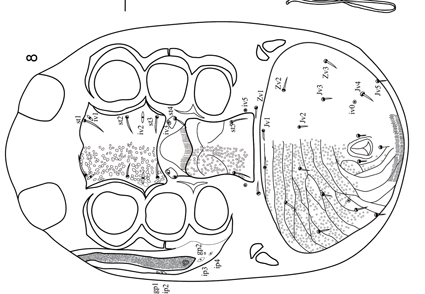Abstract
Lasioseius foliatisetus n. sp. is described based on the morphology and molecular markers of adult females collected in litter/soil samples of the Caatinga and Pantanal, extensive Brazilian biomes. This new species can be distinguished from other Lasioseius species mainly by having fixed cheliceral digit with three teeth in addition to apical tooth, most dorsal shield setae leaf-shaped, and ventrianal shield with seven pairs of setae (including Jv5) in addition to the circumanal setae. The determined nucleotide sequences of the CytB gene and of ITSS of Lasioseius foliatisetus n. sp. are the first data of these types deposited in a published database (GenBank) for a species of this genus. The phylogenetic tree generated in the analysis of ITSS sequences showed a clade constituted only by species of the superfamily Phytoseoidea, including L. foliatisetus n. sp.. The phylogenetic tree generated in the ML analysis based on CytB showed a separation of the blattisociid species (including L. foliatisetus n. sp.) in one clade and the phytoseiid species in another clade. The analysis of the 28S 1–3 domain by itself did not allow the separation of the new species here described from species of other blattisociid genera.
References
Athias-Henriot, C. (1971) La divergence néotaxique des Gamasides (Arachnides). Bulletin Scientifique De Bourgogne, 28, 93–106.
Athias-Henriot, C. (1975) Nouvelles notes sur les Amblyseiini. II—Le relevé organotaxique de la face dorsale daulte (Gamasides Protoadeniques, Phytoseiidae). Acarologia, 17, 20–29.
Argolo, P.S., Santos, J.C., Oliveira, A.R. & Moraes, G.J. (2018) Two new species of Lasioseius Berlese (Acari: Blattisociidae) from Brazil, and a key for separation of the Brazilian species of the genus. Systematic and Applied Acarology, 23, 1567–1577. https://doi.org/10.11158/saa.23.8.7
Berlese, A. (1916) Centuria prima di Acari nuovi. Redia, 12, 19–67.
Christian, A. & Karg, W. (2006) The predatory mite genus Lasioseius Berlese, 1916 (Acari, Gamasina). Abhandlungen und Berichte des Naturkundemuseums Görlitz, 77, 99–250.
Dowling, A.P.G. & OConnor, B.M. (2010) Phylogenetic relationships within the suborder Dermanyssina (Acari: Parasitiformes) and a test of dermanyssoid monophyly. International Journal of Acarology, 36, 299–312. https://doi.org/10.1080/01647951003604569
Evans, G.O. (1963) Observations on the chaetotaxy of the legs in the free-living Gamasina (Acari: Mesostigmata). Bulletin of the Natural History Museum Zoology, 10, 277–303. https://doi.org/10.5962/bhl.part.20528
Evans, G.O. (1964) Some observations on the chaetotaxy of the pedipalps in the Mesostigmata (Acari). Annals and Magazine of Natural History, Series 13, 6, 513–527. https://doi.org/10.1080/00222936308651393
Gilbert, M.T.P., Moore, W., Melchior, L. & Worobey M. (2007) DNA extraction from dry museum beetles without conferring external morphological damage. Plos One, 2 (3), e272. https://doi.org/10.1371/journal.pone.0000272
Guzmán-Larralde, A.J., Suaste-Dzul, A.P., Gallou, A. & Peña-Carrillo, K.I. (2017) DNA recovery from microhymenoptera using six non-destructive methodologies with considerations for subsequent preparation of museum slides. Genome, 60 (1), 85–91. https://doi.org/10.1139/gen-2015-0172
Ishikawa, K. (1969) Studies on the mesostigmatid mites in Japan IV. Family Blattisociidae Garman. Reports of Research Matsuyama Shinonome Junior College, 4, 111–139.
Kumar, S., Stecher, G., Li, M., Knyaz, C. & Tamura, K. (2018) MEGA X: Molecular Evolutionary Genetics Analysis across computing platforms. Molecular Biology and Evolution, 35, 1547–1549. https://doi.org/10.1093/molbev/msy096
Lindquist, E.E. (1963) A taxonomic review of the genus Hoploseius Berlese (Acarina: Blattisociidae). The Canadian Entomologist, 95, 1175–1185. https://doi.org/10.4039/Ent951175-11
Lindquist, E.E. & Evans, G.O. (1965) Taxonomic concepts in the Ascidae, with a modified setal nomenclature for the idiosoma of the Gamasina (Acarina: Mesostigmata). Memoirs of the Entomological Society of Canada, 97, 5–66. https://doi.org/10.4039/entm9747fv
Moraes, G.J., Britto, E.P.J., Mineiro, J.F.C. & Halliday, B. (2016) Catalogue of the mite families Ascidae Voigts & Oudemans, Blattisociidae Garman and Melicharidae Hirschmann (Acari: Mesostigmata). Zootaxa, 4112 (1), 1–299. https://doi.org/10.11646/zootaxa.4112.1.1
Moraes, G.J., Venancio, R., Santos, V.L.V. & Paschoal, A.D. (2015) Potential of Ascidae, Blattisociidae and Melicharidae (Acari: Mesostigmata) as biological control agents of pest organisms. In: Carrillo, D., Moraes, G. & Peña, J. (Eds.), Prospects for biological control of plant feeding mites and other harmful organisms. Progress in Biological Control. Vol. 19. Springer, Cham, pp. 33–75. https://doi.org/10.1007/978-3-319-15042-0_2
Moraza, M.L. & Lindquist, E.E. (2011) A new genus of fungus-inhabiting blattisociid mites (Acari: Mesostigmata: Phytoseioidea) from Middle America, with a key to genera and subgenera of the subfamily Blattisociinae. Zootaxa, 2758 (1), 1–25. https://doi.org/10.11646/zootaxa.2758.1.1
Narita, J.P.Z., Abduch, W.Y., Moraes, G.J. & Klingen, I. (2015) Description of a new species of Ameroseius Berlese (Acari: Ameroseiidae) from Norway, with a key to related species. Zootaxa, 4034 (2), 390–398. https://doi.org/10.11646/zootaxa.4034.2.10
Santos, J.C., Demite, P.R. & Moraes, G.J. de (2021) Blattisociidae Database. Available from: http://www.lea.esalq.usp.br/acari/blattisociidae (accessed 20 February 2021)
Santos, V.V. & Tixier, M.-S. (2017) Which molecular markers for assessing which taxonomic level? The case study of the mite family Phytoseiidae (Acari: Mesostigmata). Cladistics, 33, 251–267. https://doi.org/10.1111/cla.12166
Sourassou, N.F., Moraes, G.J., Delalibera Jr., I. & Corrêa, A.S. (2015) Phylogenetic analysis of Ascidae sensu lato and related groups (Acari: Mesostigmata: Gamasina) based on nuclear ribosomal DNA partial sequences. Systematic and Applied Acarology, 20, 225–240. https://doi.org/10.11158/saa.20.3.1
Thompson, J.D., Gibson, T.J., Plewniak, F., Jeanmougin, F. & Higgins, D.G. (1997) The ClustalX windows interface: flexible strategies for multiple sequence alignment aided by quality analysis tools. Nucleic Acids Research, 24, 4876–4882. https://doi.org/10.1093/nar/25.24.4876
Tixier, M.-S., Okassa, M. & Kreiter, S. (2012) An integrative morphological and molecular diagnostics for Typhlodromus pyri (Acari: Phytoseiidae). Zoologica Scripta, 41, 68–78. https://doi.org/10.1111/j.1463-6409.2011.00504.x
Walter, D.E. & Lindquist, E.E. (1989) Life history and behavior of mites in the genus Lasioseius (Acari: Mesostigmata: Ascidae) from grassland soils in Colorado, with taxonomic notes and description of a new species. Canadian Journal of Zoology, 67, 2797–2813. https://doi.org/10.1139/z89-396
Walter, D.E. & Lindquist, E.E. (1997) Australian species of Lasioseius (Acari: Mesostigmata: Ascidae): the porulosus group and other species from rainforest canopies. Invertebrate Systematics, 11 (4), 525–547. https://doi.org/10.1071/IT96003
Walter, D.E. & Lindquist, E.E. (2000) Arrhenoseius gloriosus n. g., n. sp. (Acari: Mesostigmata: Ascidae), an arrhenotokous mite from rainforests in Queensland, Australia. Acarologia, 41, 53–68.
Womersley, H. (1956) On some new Acarina-Mesostigmata from Australia, New Zealand and New Guinea. The Journal of the Linnean Society of London, Zoology, 42, 505–599. https://doi.org/10.1111/j.1096-3642.1956.tb02218.x


